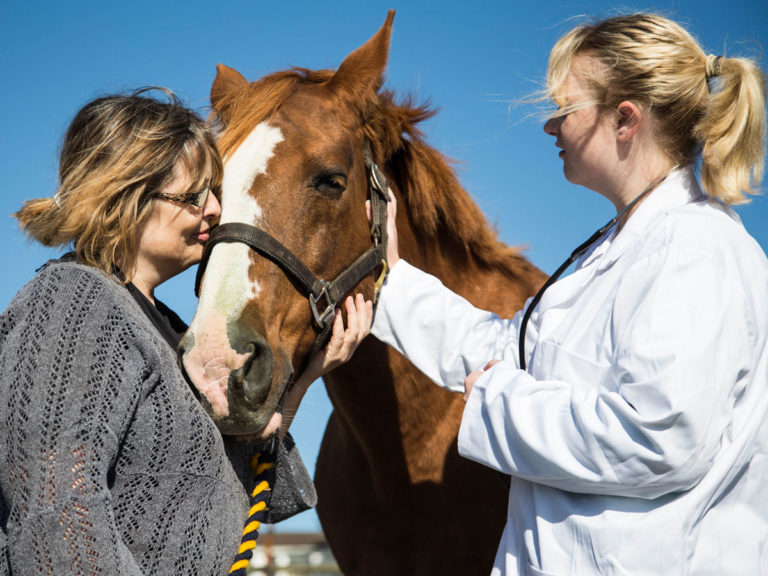
Horse owners often turn to their vets to help explain some behavioral quirks in their horses. This is especially true when usually well-behaved individuals turn into monsters with snaking heads, biting jaws, flattened ears, swishing tails, humped backs and attempts at sidewise maneuvers to avoid an action they resent.
A common problem arises when a rider attempts to tighten the girth or cinch on his or her horse. Some horses never like this action, so their behavior is excused as just being “girthy.” Other horses never pay any attention to the girth tightening—until they do so violently.
With this in mind, a research project looked into possible reasons why a horse might display “girthiness” [Millares-Ramirez, E.M., and Le Jeune, S.S., Girthiness: Retrospective Study of 37 Horses (2004-2016), Journal of Equine Veterinary Science 2019, vol. 79; pp. 100-104]. Twelve years of records at the University of California, Davis, Veterinary Teaching Hospital were reviewed on 37 horses presented primarily for a complaint of girth aversion.
A variety of breeds or types were represented, including Thoroughbreds, warmbloods, Arabians, Quarter Horses and ponies. Dressage predominated as the equestrian pursuit, followed by pleasure riding, jumping, endurance, trail riding and three-day eventing, with a couple of other horses involved in barrel racing and therapeutic riding.
The medical records detailed findings from full physical exams that included vital signs and musculoskeletal evaluation with palpation of the back and limbs along with passive range-of-motion and flexion tests. Horses were also exercised on hard and soft ground, on straight lines and on longe lines. Other evaluations included gastroscopy (13), abdominal radiography (3), saddle fit (7) and ultrasound (which was done on a case-by-case basis).
Of the 13 horses that had gastroscopy, 12 were positive for gastric ulcer disease. Ten of the 12 had equine gastric ulcer syndrome (EGUS) severity of Grade 1 and 2, and two horses were categorized as Grade 3. All were put on omeprazole therapy (4 mg/kg orally once daily) for at least a month. The more severe ulcerative disease cases were treated for three to six months. All 12 owners reported that girthiness resolved with omeprazole treatment.
Ten of 37 horses were positive for orthopedic issues, including thoracic and lumbar vertebral osteoarthritis (4), cervical vertebral osteoarthritis (3), bone spavin (2) and front limb lameness (1). Each problem was addressed individually. Owners reported that all 10 horses improved with appropriate treatment for their musculoskeletal issue.
Back pain was evident in three horses due to ill-fitting saddles from a broken tree, an overly narrow gullet or uneven flocking. The saddles were changed to ones with a good fit, and all three received acupuncture and chiropractic treatment with positive responses.
The other 11 “girthy” horses had a variety of diagnoses, including painful withers, liver abscess, ovarian tumor, sternum pain, aneurysm of the vena cava, urinary tract infection, girth mass, sand impaction, sacroiliac pain and one simply had a behavioral issue.
Overall, the primary reasons for girthiness in this retrospective study were from gastric ulceration (37%), orthopedic issues (27%) or poor saddle fit (8%). Prophylactic omeprazole treatment is recommended in advance of transport or competition.
Lameness under saddle often elicits behavioral changes due to pain, and girthiness might be one such sign. Vertebral pain can be amplified by girth tightening and/or when the horse is ridden. An ill-fitting saddle contributes to atrophy and pain of the epaxial muscles as well as localized pain and/or abnormal wear on hair beneath the saddle.
Many times, horse owners present their horses to their veterinarians expecting instant analysis and identification of their horses’ behavioral problems. Such owner expectations are challenging to the equine practitioner, particularly with owners who don’t want to invest considerable financial resources in tracking down the reason for a horse’s discomfort.
Because of the non-specific nature of girthiness, it is recommended to do a thorough physical and musculoskeletal examination and to explore other possibilities through gastroscopy and imaging. Careful evaluation of saddle fit by a competent saddle fitter is also instrumental in uncovering possible reasons for a horse’s aversion behavior.
While girthiness was a complaint in only 0.09% of the medical records reviewed over a dozen years in this retrospective study, it is still a large cause of concern not only because some horses can become dangerous in their aversion behavior, but also for the impact it can have on a horse’s performance. It is likely that there are many more cases of girthiness that are not brought to the attention of equine veterinarians.
During veterinary visits, it might be worthwhile to inquire whether a horse is experiencing such an issue; then you can offer a systematic strategy to identify a possible source of the problem. Ultimately, this helps to improve a horse’s comfort and performance, as well as improving client satisfaction.








